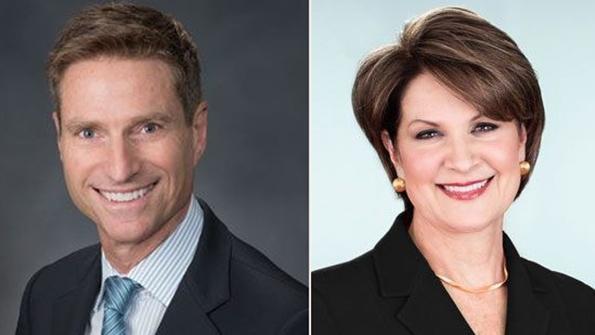
Lockheed Martin Chairman, CEO and President Marillyn Hewson became the prime example of how to stumble into the corner office of the Pentagon’s top contractor and still provide laudable business results. Now, as she hands off the reins to an enigmatic successor, Lockheed stakeholders hope the uncertainty ahead will be just as lucrative.
- New leader chosen from outside the company’s ranks
- Analysts say CEO-designate may mean more commercial work
On March 16, the Bethesda, Maryland-based prime—the largest contractor to the U.S. Defense Department by annual sales—surprised many followers with the news that current Lockheed board member James “Jim” Taiclet, Jr. will become CEO and president on June 15, while Hewson becomes executive chairman.
Lockheed also promoted Frank St. John, current executive vice president of the company’s Rotary and Mission Systems (RMS) division, to become chief operating officer (COO)—a role that Hewson technically held last, and briefly, before her January 2013 appointment as chief executive. Before that, the COO role was mostly held by Chris Kubasik prior to his downfall at Lockheed. Stephanie Hill, now senior vice president for enterprise business transformation, was appointed to succeed St. John as executive vice president for RMS. These appointments also are effective June 15.
Hewson is 66 years old and Taiclet is 59. The company, which does not have a retirement rule, had not announced a formal transition plan or successor process. Nevertheless, industry insiders were watching movements—such as St. John’s rise and recent board appointments—and analysts said they assume the transition was planned before the ongoing COVID-19 crisis erupted.
While the announcement was a surprise, the timing was not—due to Hewson’s age and the fact that Lockheed ended 2019 with a record $144 billion backlog of work and a stock price that has more than tripled under Hewson, including the recent COVID-19-related pullback. Still, many observers are intrigued by the selection.
“While Marillyn’s retirement has been in the cards for a while, we were not expecting Lockheed to go outside the company for its new CEO,” say analysts at Vertical Research Partners. “Taiclet has an impressive pedigree based on his resume, but from an A&D perspective, he is an unknown quantity. . . . But with Marillyn sticking around as chairman, and a very experienced cohort of senior Lockheed managers, we are not expecting there to be any revolutionary change as a result of this appointment.”
Cowen analysts also noted that St. John’s appointment as COO further bookends Taiclet with experienced Lockheed managers. St. John, 53, joined Lockheed more than 30 years ago and as COO is naturally positioned as a potential future CEO, analysts say.
Taiclet is currently chairman, president and CEO of American Tower, a real estate investment holding company and owner/operator of wireless and broadband communications networks, where he has held the executive reins since 2003. He joined that company in 2001 and, according to Lockheed, is credited with guiding American Tower’s transformation from a U.S.-centric focus to a multinational business outlook. Analysts said he also was central in leading mergers and acquisitions as part of the company’s expansion. American Tower announced an immediate replacement for Taiclet but said he will remain chairman and an advisor through June 14.
Taiclet previously served as president of Honeywell Aerospace Services and before that was vice president for engine services at the Pratt & Whitney division of United Technologies (UTC). He also worked as a consultant at McKinsey & Co., specializing in telecommunications and aerospace strategy and operations. He is a retired U.S. Air Force pilot and Persian Gulf War veteran.
Loren Thompson, a Lexington Institute consultant to Lockheed, says Hewson’s selection of Taiclet seems calculated to continue her emphasis on tight financial management and good customer relations while positioning the leading prime for a changing demand environment.
“That environment will be characterized by two shifts from previous years,” Thompson writes. “First, the defense budget will enter a flat to declining period very different from the spending increases of the early Trump [administration] years. Second, the preference of military customers for nontraditional suppliers who think like entrepreneurial enterprises rather than government contractors will continue to grow.”
Hewson’s selection of Taiclet also is telling because she has won the respect of many industry insiders, analysts and advisers. While unplanned, Hewson’s tenure as CEO was deemed successful by most.
“Hewson’s tenure is known for operational execution with such programs as the F-35, while having a successful oversight in maintaining key businesses—such as in the evolving area of space with wins such as Next-Gen OPIR and GPS IIIF,” say Jefferies analysts. Company sales grew at a 5% compound annual growth rate from $45.4 billion in 2013 to an expected $63.3 billion this year.
Taiclet’s takeover sounds to many like more of the same—but different. “This is the first time Lockheed Martin has promoted someone who did not rise through the corporation to be president and CEO,” writes Capital Alpha Partners analyst Byron Callan. “We find it intriguing that he has a commercial background and wonder if that’s not a different direction the company starts to explore in 2020-25.”





